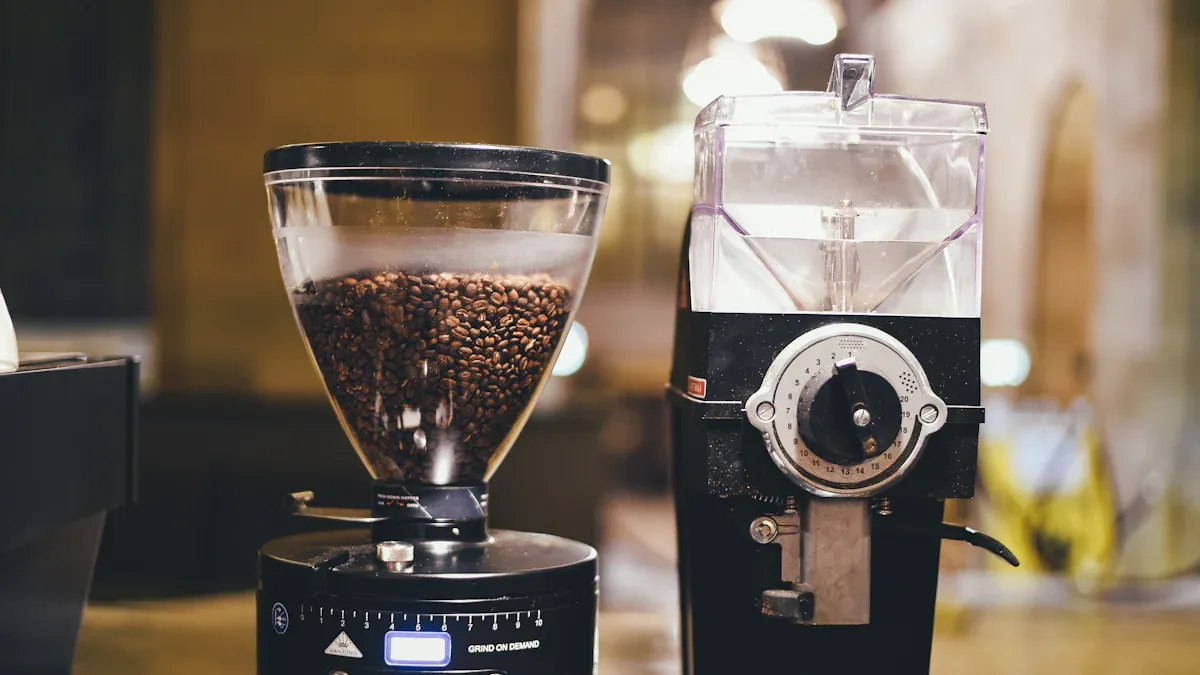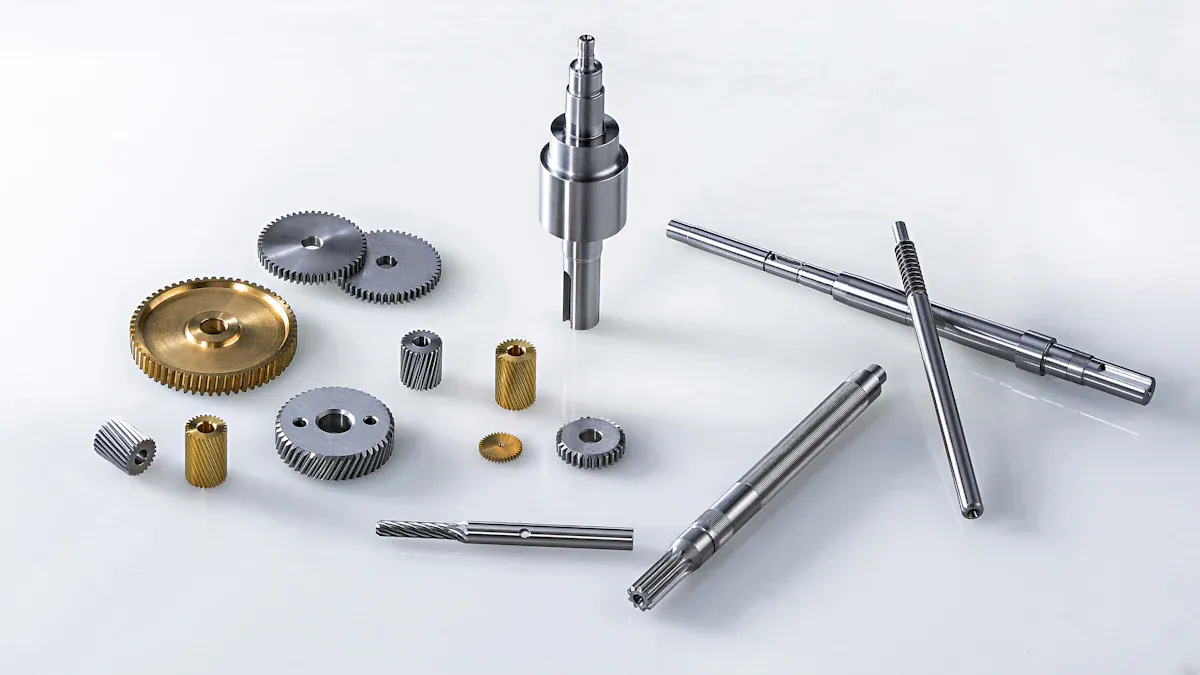
What is difference between meat grinder and mincer? In 2025, meat grinder and mincer technology seamlessly combines tradition with innovation. These machines, equipped with sharp blades, augers, and powerful motors, efficiently process meat into uniform pieces, catering to both home cooks and professionals. With advancements such as IoT and AI, meat grinders now deliver enhanced efficiency and energy-saving capabilities. Additionally, the demand for customizable food machinery accessories continues to rise as consumers look for smarter and more adaptable solutions.
Key Takeaways
- Know the difference: Grinders crush meat into different textures. Mincers chop and mix meat finely. Pick what fits your cooking needs.
- Use new tech: Today’s grinders and mincers have smart features. They save energy and clean themselves, making them simple to use.
- Pick the best type: Manual grinders cost less and work for small jobs. Electric grinders are faster and handle more meat. Think about how you cook.
What is difference between meat grinder and mincer?
Grinding: Cutting and crushing meat into coarse or fine textures
Grinding involves breaking down meat into smaller, coarse, or fine pieces. A meat grinder uses an electric motor to power an auger, which pushes the meat through a cutting plate. Rotating blades then slice the meat into the desired texture. This process is ideal for preparing ground beef, burger patties, or even grinding other ingredients like nuts and grains. The versatility of grinders makes them a popular choice for both home kitchens and professional settings.
Mincing: Finely dividing meat into uniform, smaller pieces
Mincing focuses on precision and uniformity. A meat mincer uses a specialized mincing knife to finely chop and mix meat. The auger in a mincer rotates to guide the meat into the blades, ensuring consistent results. This method is perfect for recipes requiring finely chopped meat, such as sausages or meatballs. Unlike grinders, mincers can also handle other tasks like chopping vegetables or juicing, making them a multifunctional tool.
Key distinctions in methods and equipment
The differences between grinders and mincers lie in their design and purpose. Grinders excel at breaking down meat into various textures, while mincers specialize in fine chopping and mixing. Here’s a quick comparison:
| Feature/Function | Meat Mincer | Meat Grinder |
|---|---|---|
| Primary Use | Fine chopping and mixing of meat, fish, and vegetables | Grinding meat into smaller pieces |
| Mechanism | Uses a mincing knife for chopping | Uses an electric motor and auger for grinding |
| Versatility | Can also chop vegetables, make sausages, and juice | Primarily focused on grinding meat |
Both tools play unique roles in the kitchen. While a grinder offers versatility, a mincer provides precision. Choosing the right one depends on the user’s needs and the type of dishes they want to prepare.
Types of Meat Grinders and Mincers

Manual grinders: Affordable and simple to use
Manual meat grinders remain a popular choice for those who value simplicity and affordability. These grinders operate without electricity, making them ideal for small-scale use or areas with limited power access. They’re lightweight, portable, and easy to maintain. Models like the #10 and #22 can process 2-3 lbs. and 3-4 lbs. of meat per minute, respectively. While they require more effort, they’re perfect for occasional use in home kitchens.
| Grinder Type | Manual Capacity (lb/min) | Electric Capacity (lb/min) |
|---|---|---|
| #10 | 2-3 | 5 |
| #22 | 3-4 | 9 |
| #32 | 5 | 12 |
For those who enjoy hands-on cooking, manual grinders offer a satisfying experience. They’re also a cost-effective option compared to electric models, which process meat at twice the speed but come with a higher price tag.
Electric grinders: High power and efficiency
Electric meat grinders have revolutionized meat processing with their speed and convenience. Small home models can handle about 5 lbs. of meat per minute, while larger commercial models process up to 100 lbs. per minute. These machines cater to both home cooks and professionals, offering consistent results with minimal effort.
| Power Rating | Description | Target Users |
|---|---|---|
| 500W-1000W | Mid-range grinders suitable for moderate volumes with balanced efficiency. | Households and small-scale commercial |
| Above 1000W | Heavy-duty models designed for continuous operation and high volume. | Commercial establishments and chefs |
| Energy Efficiency | Focus on optimizing motor efficiency to reduce energy consumption. | All users seeking sustainable options |
Electric grinders are perfect for those who need to process large quantities of meat quickly. They’re also more versatile, handling tasks like grinding vegetables or making sausages. Ningbo Pingheng Machinery Co., Ltd. contributes to this innovation by providing high-quality precision casting solutions for durable and efficient grinder components.
Advanced models in 2025: Smart features and automation
In 2025, advanced meat grinders and mincers have embraced smart technology and automation. These models offer features like multiple grinding settings, safety mechanisms, and even self-cleaning options. They cater to the growing demand for convenience and efficiency, making them indispensable in modern kitchens.
| Trend Description | Impact |
|---|---|
| Growing Demand for Electric Meat Mincers | Shift from manual to electric models for convenience and higher processing capacities. |
| Technological Advancements | Enhanced functionality with features like multiple grinding settings and safety mechanisms. |
| Rising Popularity of Multi-functional Meat Mincers | Increased versatility with additional tasks like sausage stuffing and pasta making. |
These innovations make it easier than ever to prepare meat for various dishes. Whether you’re a home cook or a professional chef, these smart grinders save time and effort while delivering precise results. The integration of IoT and AI ensures that these machines adapt to user preferences, setting a new standard for meat processing.
Key Components and Modern Features

Feeding tray and auger: Guiding and moving meat
The feeding tray and auger work together to guide meat into the grinder or mincer. The tray holds the meat, while the auger—a spiral-shaped component—moves it toward the blades. This design ensures a smooth and consistent flow, preventing clogs. In 2025, manufacturers have improved auger designs to handle tougher cuts of meat with ease. These upgrades make the process faster and more efficient, whether for home use or commercial kitchens.
Blades and plates: Cutting and shaping meat
Blades and plates are the heart of any meat grinder or mincer. The blades slice through the meat, while the plates determine the final texture. Plates come in various sizes, allowing users to choose between coarse or fine results. Modern machines now feature stainless steel components for durability and hygiene. Ningbo Pingheng Machinery Co., Ltd. contributes to this innovation by providing high-quality precision casting solutions, ensuring these parts remain reliable and long-lasting.
Motors and energy efficiency: Powering the process
Motors power the grinding process, and their efficiency has become a key focus in 2025. Manufacturers optimize motor designs to reduce energy consumption while maintaining high performance.
- High-power models now consume less energy, aligning with environmental goals.
- Horsepower (HP) ratings help users identify the right machine for their needs. Higher HP ensures better energy efficiency and performance, especially for industrial grinders.
These advancements meet consumer demand for sustainable and cost-effective appliances.
Smart technology and self-cleaning: Innovations in 2025
Smart technology has transformed meat grinders and mincers. Machines now feature sensors that adjust settings automatically, reducing manual input. Safety has also improved with automatic shut-off functions.
- Smart sensors enhance precision and efficiency.
- Self-cleaning features simplify maintenance and ensure hygiene.
- Government initiatives encourage the adoption of these advanced technologies.
| Key Trends | Description |
|---|---|
| Smart Technology Integration | Sensors and automation improve efficiency and safety in meat processing. |
| Advanced Sanitation Designs | Self-cleaning features meet food safety standards and reduce maintenance. |
| Demand for User-Friendly Designs | Easy-to-clean machines cater to consumer preferences for hygiene. |
These innovations make modern grinders and mincers indispensable tools in kitchens. They save time, reduce costs, and ensure compliance with food safety regulations, setting a new standard for meat processing.
Meat grinders and mincers in 2025 have become essential tools for modern kitchens. They combine traditional methods with advanced features like smart technology and energy-efficient designs. These innovations save time and improve appliance longevity, making them a valuable investment for both home cooks and professionals.
The global market for meat processing tools is expected to reach $2.5 billion by 2025, driven by the rise of convenience foods and homemade recipes. Companies like Ningbo Pingheng Machinery Co., Ltd. contribute to this growth by providing durable, high-quality components for these machines.
| Aspect | Details |
|---|---|
| Technological Advancements | Enhanced efficiency, safety, and hygiene in grinder design. |
| Adoption Trends | Increased use of automated and high-capacity grinders in large-scale processing plants. |
| Market Growth | Significant growth driven by demand for processed meat products and homemade recipes. |
Understanding the differences between grinding and mincing, along with the types and features of these machines, helps users make smarter choices. With proper care, these tools enhance efficiency and convenience, setting a new standard for meat processing.
FAQ
How do I choose between a manual and an electric grinder?
Manual grinders suit occasional use and small portions. Electric grinders handle larger quantities quickly, making them ideal for frequent or commercial use.
Can I grind bones with a meat grinder?
Some heavy-duty grinders can process soft bones like chicken. Always check the manufacturer’s guidelines to avoid damaging the machine.
Tip: Ningbo Pingheng Machinery Co., Ltd. provides durable components that enhance grinder performance, ensuring reliability for tasks like grinding tougher cuts or soft bones.
Are meat grinders safe to use?
Yes, modern grinders include safety features like automatic shut-off and non-slip bases. Always follow the user manual for safe operation.
